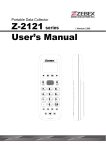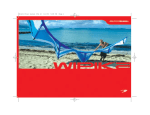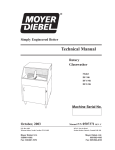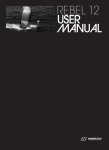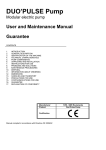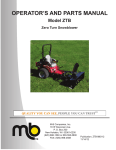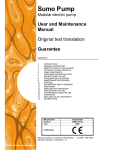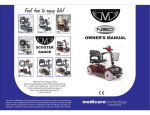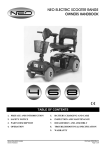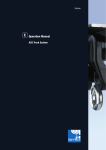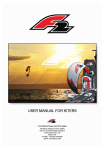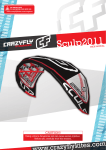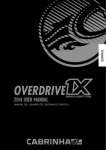Download 2005
Transcript
WIPIKAMANUAL WWW.WIPIKAKITEBOARDING.COM CONGRATULATIONS GENERALWARNING Release of Liability and Assumption of Risk By assembling and/or using this Wipika kiteboarding product, you agree that you have read and understood the entire Wipika User’s Manual, including all instructions and warnings contained in this manual, prior to using the Wipika kiteboarding product in any way. You additionally agree that you will ensure any additional or subsequent user of your Wipika kiteboarding product will read and understand the entire Wipika User’s Manual, including all instructions and warnings contained in this manual, prior to allowing that person to use your Wipika kiteboarding product. Assumption of Risk: Use of the Wipika kiteboarding product and any of its components involve certain inherent risks, dangers, and hazards which can result in serious personal injury and death to both the user and non-user third parties. In using the Wipika kiteboarding product, you freely agree to assume and accept any and all known risks of injury to you and to third parties while using this equipment. The risks inherent in this sport can be greatly reduced by abiding by the warning guidelines listed in this manual and by using common sense. Release and Waiver of Claims: In consideration of the Wipika kiteboarding product to you, you hereby agree to the fullest extent permitted by law, as follows: 3 To Waive Any and All Claims That you have or may in the future have against Wipika International Ltd and all related parties resulting from use of the Wipika kiteboarding product and any of its components. To Release Wipika International Ltd. and all related parties from any and all liability for any loss, damage, injury or expense that you or any users of the Wipika kiteboarding product may suffer or that your next of kin may suffer, as a result of the use of the Wipika kiteboarding product, due to any cause whatsoever, including negligence or breach of contract on the part of Wipika International Ltd. and all related parties in the design or manufacture of the Wipika kiteboarding product and any of its components. In the event of your death or incapacity, all provisions contained herein shall be effective and binding upon your heirs, next of kin, executors, administrators, assigns, and representatives. Wipika International Ltd. related parties have not made and expressly deny any oral or written representations other than what is set forth herein and the Wipika User’s Manual. Congratulations on purchasing your Wipika kite! Since the beginning our product design has been focused on safety, user-friendliness, and technical innovations. For 2005, we have focused on making our products lighter and stronger by focusing on small details such as Reflex Struts, Single Struts, and superior manufacturing techniques. We’re also excited to continue offering the Central Line System in our continual push to increase safety standards. Please read through the following manual for information on how to get started using your Wipika kite quickly and safely. TABLEOFCONTENTS Safety and Warnings 05 Wind Ranges 07 Kite Features 09 Bar Features 11 The Central Line System (CLS) Overview: 12 SET UP Kite Inflation 13 Bar Set-Up and Safety System Attachment 15 Safty Leash 17 Kite Connection 19 Tuning 21 USING CLS Power Stop/ Power Start, Self-Landing 23 Power Meter 24 CLS Tips 24 Packing Up Bar 25 Packing Up Kite 26 SUPPORT The information contained in this manual is for your reference and may be subject to change at anytime. Please visit our website at www.wipikakiteboa rding.com for the most current updates to this manual. Care and Maintenance 27 Advice and Troubleshooting 28 Glossary 29 Warranty Policy 30 4 GENERALSAFETYANDWARNINGS Kiteboarding is dangerous. Wipika kites are designed exclusively to fly over water only, not on land. For safety reasons Wipika kites are to be used for kiteboarding only. Always check the local wind conditions before flying a kite. Stay clear of all obstacles such as people, trees, buildings, rocks, airports, and power lines. Always keep a safe distance from all objects downwind. Be familiar with safety systems and rescue techniques before ever attempting kiteboarding. This manual is not comprehensive; seek certified instruction before attempting to fly a Wipika kite. Constantly Monitor the Weather: Check local weather patterns and forecasts. Never kite in wind conditions that are likely to change dramatically. Never kite in gusty conditions or winds too strong for you to maintain precise control of the kite at all times. Never kite in onshore winds; you can be dragged over land. Never kite in offshore winds; you can be dragged out to deep water. Never kiteboard when overpowered. Avoid kiteboarding in storms; you may be electrocuted or hit with large gusts. Safety of Others: You are responsible for ensuring that your actions and equipment do not endanger other people. Stay clear of crowds, swimmers, and all other 5 obstructions within a 100-meter perimeter downwind. Ensure that all bystanders are upwind of you and the kite. Ensure that others are aware of your flying lines at all times. Watch where other kiters and water users (surfers, swimmers, kayakers, etc.) are on the water. Always look for other kiters before jumping or changing directions. Detach flying lines when not in use. The kite can accidentally launch and tension the lines causing harm to yourself or others. Ensure that you are able to maintain precise control the kite under all circumstances. Your Own Safety: Know your ability and limitationsover confidence and fatigue are two major causes of kiteboarding accidents. Practice and be familiar with your safety mechanisms. Perform pre-flight checks of lines, connections, leader lines, safety systems, harness, etc; replace if worn or damaged. Never use lines with knots, they are significantly weaker and will break more easily. Never kiteboard out further than you can swim back. Always use a kite leash with a reliable quick release. Never use a kite to jump over land. Avoid standing on land with kite above your head, you can be lifted and dropped on the beach or obstacles. Before kiting, tell someone when you are leaving and when you expect to return. General Safety: Use your judgment- do not go kiteboarding unless you feel comfortable. Practice kiteboarding only while in unobstructed water. Do not kite within 5 km of any airport. Avoid kiting near power lines. Secure kites not in use with sand, leading edge down. Detach lines of unattended kites. Be mindful of flying lines. Use extreme caution whenever connected to kite. Be aware of the usual risks associated with water sports including, but not limited to drowning, sunburn, reef cuts, marine life, and hypothermia. Wear a coast guard approved personal floatation device. Wear a helmet, especially if using a board that is leashed to your body. Precautions: When using kiteboarding equipment you run the risk of: Being dragged over land or into objects or people. Being lifted and dropped on land or obstacles. Being dragged out into deep water. Lines wrapping around your arms, legs, or neck and tensioning with the kite power. Courtesy and Right of Way Talk with locals before kiting in any new spots and let them know your plans. When passing downwind of other kiters, keep your kite low to the water, passing your kite under the upwind kite. When passing upwind of other kiters, keep your kite high above the water, passing your kite over the downwind kite. Look for other kiters before jumping or changing directions. Right of way is determined by size of vessel, but closest to the wave peak has priority, followed by kites in neutral position. Be considerate and do your best to stay out of everyone’s way while you kiteboard. Help other kiteboarders to launch and land. Watch out for others and they might watch out for you. 6 WIND RANGES Below are general wind range references. This is a general guide and is not meant to be a substitute for proper on-the-beach assessment of kite selection. 7 BFT KM/H KNOTS NOTES 1 1-5 1-3 Still air/ almost no wind 2 6-11 4-6 Gentle breeze > 21 m² 3 12-19 7-10 Light winds > 14 to 19.5+ m² 4 20-28 11-16 Whitecaps 14 to 19.5 m² 5 29-38 17-21 Sand blowing on beach 7 to 16 m², maximum 7.0 for learners 6 39-49 22-27 Flags flapping, no beginners 5 to 14 m², extra caution required 7 50-61 28-33 Strong winds < 10 m², experts only 8 62-74 34-40 Dangerous conditions Kiteboarding not recommended 9 75-88 41-47 Highly dangerous conditions Do not kiteboard 10+ >89 >48 Extreme conditions Do not kiteboard Recommended size for 75-80kg/165-176lb rider on 130 cm board 8 ����� KITEFEATURES Central Line System (optional) - Safety that works. Single Strut- Shaped strut with one-piece construction for light weight and durability. �������� ���� ������ Reflex Strut- Curved struts for stability in larger sized kites. Turn Power Adjusters- For extensive turning style options and tunability. Inflatable wingtips- Floats better, helps relaunch, packs lighter and smaller. Single-Point Attachment Struts - Struts can twist, allowing the kite to depower in gusts. Creates a smoother feel and easier relaunch. Kitesaver Strip- Strengthens and protects the leading edge from tears. Pump Leash- Holds the kite, freeing both hands to pump the leading edge. ����� Easy-Connect pigtails- Color-coded and reversed knots to simplify kite line connection. Direct-Connect- Wipika kites are ready to fly directly out of the bag. No bar rigging. ������� ���� COMPLETE KITE PACKAGE INCLUDES: Kite Control Bar Pre-Rigged Line Set 9 Expandable Kite Bag Aluminum Shaft Pump Allen Key Bladder Repair Kit Warranty Card CD-ROM User’s Manual ���� ��� 10 CENTRALLINESYSTEM BARFEATURES CLS-ADVANTAGES Pre-rigged bar and lines for fast and easy set-up. 1 On-the-fly power adjustment for immediate power control. Safety-Complete depower. 7 8 9 Easy-to-use safety release. 2 Bar Indicator: if the word “Wipika” faces you, the bar is right- side-up. Ergonomic bar construction for reducing strain on your wrists and arms. 3 4 Depower-Use CLS to depower kite, without crashing kite. Kite can be flown without pulling on the rider. Extends wind range. 3 Power Stoppers for customizable depower distance. CLS equipped- Safety that works. 5 6 11 Power Stop/Start- Completely depower the kite on demand. Instantly re-power kite. 1 LINE ADJUSTMENT KNOTS 2 PU SLEEVED LEADER LINE 3 ADJUSTABLE STOPPER BALLS 4 CLS LEASH RING 5 SAFETY QUICK RELEASE 6 CHICKEN LOOP 7 ONE-LOOP DEPOWER STRAP 8 CLS LINE 9 RE-RIDE SAFETY Relaunch Helpful during water starts. Self -Land-Safely self-land using CLS. 12 KITESETUP KITE INFLATION Locate wind direction. Roll out kite in area with no sharp objects, thorns, etc.... 13 Lay out kite folded in half- wingtips downwind. Weight upwind side of kite with board or sand. Begin at wingtips, pump struts until firm. Pump all struts while working towards Leading Edge (LE) valve. Connect Pump Leash. Close large valve. Pump leading edge. Flip kite over. Weight with sand or board 14 BARSETUP 15 LINES Unroll lines until straight. Have a friend hold bar. Double check front (center) lines for equal length. Double check back (outside) lines for equal length. CLS LINE CLS should be even with front flying lines. Note: front lines will stretch after the first few uses. Please readjust the CLS after first uses so that it is even with front flying lines. If uneven back lines, adjust using knots on outside line. CLS line comes assembled on 05 kite bars. Remove Central Line if not desired. ADJUSTABLE POWER STOPPERS Adjust CL line stoppers to desired position using Allen key. SAFETY RELEASE Practice and be familiar with the function of the safety release. To release bar: pull red safety sleeve away from your body. WIPIKA RECOMMENDS: Base stopper: 5 cm from top of safety for full safety function. Top stopper: adjust to comfortable arm’s length when hooked in. To reconnect bar: thread straps through ring. Replace safety sleeve. 16 SAFETY LEASH RE-RIDE STOPPER BALL USING A LEASH IS MANDATORY FOR SAFE KITING. To attach safety release to the harness. Slide red sleeve down. Place pin through ring and back into red sleeve. Slide red sleeve back over pin and secure tightly. Hook safety leash to CLS ring near Chicken Loop. Optional feature to prevent bar from sliding up when re-ride safety system is released. To remove ball: un-thread line from the ball. Move line on adjustment knot on outside leader line to make lines even. 17 Pull line through loop and tighten. Change adjustment knot on outside line leader to make lines even. FIX TUBE For shackled riding, place fix tube through spreader bar. LEASH ATTACHMENT TO BAR Safety system options: CLS leash atttachment To use the CLS as a safety system, attach the safety leash to the CLS ring. When the safety leash is attached to the CLS ring the kite will depower from the leading edge using the CLS. Attach the leash to the CLS ring whenever the CLS is rigged on the kite. To replace ball: slide sheath up outside flying line 15 meters. Place line through ball, loop line through ball again. Re-ride leash attachment. When not using the Central Line System, attach the safety leash to the outside line re-ride ring. When the safety leash is attached to the outside line re-ride ring the kite will depower from the outside line. 18 CONNECTION Place pumped kite 30 meters downwind, leading edge down. Place CLS bridle upwind of kite. Start below right wingtip, unroll lines upwind. Pull lines upwind until in a straight line. Back lines: Connect to last or second to last pigtail knot. Spin bar to untangle twists near bar. Walk out the two turning (outside lines). Place apart on ground. Walk out front (center) lines. Place CLS line between the two front lines. Keep separate; pick up left side back line, front line, and CLS line. CENTRAL LINE Walk around leading and connect CLS line to CLS bridle. At left wingtip, connect front (inside) line, and then back (outside) line. Connect back lines to last or second to last pigtail knot *This technique reduces tangles. INSIDE FLYING LINE Keep separate; pick up right side back line and front line. At right wingtip, connect front (inside) line, and then back (outside) line. OUTSIDE FLYING LINE Connect back lines to last or second to last pigtail knot 19 20 KITE TRIM SYSTEM Always tune your kite to the conditions ONE-LOOP SYSTEM To de-power kite: pull back part of de-power loop towards your body. To power kite: pull front part of de-power loop towards your body. 21 FLIGHT TUNING Proper Tuning with kite flying. Kite connection: Place back lines on last or second to last pigtail knot With kite flying in neutral, CL hooked in, bar at top stopper, look at flying lines for: Bar Connection: Left back line on second knot from top. Right back line on re-ride ring. Center lines on top knot. 1. Tight front (center) lines. Full load on front lines. Please note: front lines will stretch after first use. Please move them to second or third knot from the top after stretching. Routinely check that CLS line and front lines are equal length with chicken loop pulled 10cm and depower strap fully extended. Adjust if uneven. Routinely check that CLS line and Chicken Loop line for wearing. Replace if wearing! 2. Back (outside) lines become tight when bar is pulled to half de-power range. Use the de-power strap and pigtail knots to adjust lines properly. 3. CLS line is straight, but not tensioned. Front lines and CLS line should be equal length. 22 USING CLS ON THE WATER POWER METER: CLS can be used as depower. Simply pull CLS line to depower the kite. If kite stalls or flies backwards, pull CLS to fly kite forwards. CLS TIPS: 23 POWER STOP In the case of an emergency: Release the bar using safety release or unhook from bar and let go. Kite will immediately lose power and fall downwind. POWER START No need to swim to kite. Pull CLS until kite rolls onto back. NOTE: twists in flying lines may cause CLS to function improperly. NOTE: Always release the CLS safety if kite begins to roll. Not releasing the Central Line when the kite rolls can tear the kite. NOTE: pulling on the outside leader line can help taxi the kite to edge of wind window. NOTE: If kite falls with trailing edge on water pull CLS and kite will restart immediately. Proceed with conventional water start. SELF-LANDING (experts only): Return to beach with clear area 4050 meters downwind. Turn kite into wind window and release bar. Kite will fall downwind. Once landed, secure CLS leash to weighted board, anchor, etc…. Flip kite over, leading edge down, secure with sand. CLS works best with full power in kite (center of wind window). Don’t release CLS when kite at edge of wind window. Tip: For extra spinability of CLS remove Central Line from the V-connection ring. 24 PACKING UP KITE PACKING UP BAR Pull bar back to end of CLS leash. (1) Flip kite over, wingtips up. 1. Holding bar in one hand. Grab leader lines and depower strap, wind tightly around bar in figure 8 motion. For CLS, all lines will fit neatly onto the bar. Release leading edge valves. Pull center strut and allow kite to fold, leaving wingtips downwind. (2) Weight upwind side of kite. (3) Release strut valves. With wingtips together, fold kite towards center strut. (4) Neatly fold kite in 3 along the strut. (5) 1 1 2. Once to flying lines, tightly wind lines around bar end in figure 8 motion. 3. With 1 meter flying line remaining, 2 tightly hitch-knot lines around both bar ends for neat storage. 2 4 3 5 *This method keeps sand out of stored kite. Easy for windy conditions. *Tight winding and tight hitch knots will prevent tangles. 3 25 26 SUPPORT The kite does not launch or fly well. PERFORM ROUTINE INSPECTION FOR WEAR AND TEAR ON: Flying Lines Pigtails Kite Line Connections Depower System Safety System Kite Canopy-look for punctures Replace if worn. BAR AND LINES Wind lines on bar and rinse in fresh water after every use. Check for knots in lines, these can cause breakage. PUMP Avoid contamination with sand or dirt. If necessary pull apart, clean and reassemble with lubricant. PANEL REPAIR If kite panel is damaged, place sail ape on both sides of the tear. For large kite panel rips, sew around edges of rip with a new section of panel material. Always sew with professional grade zigzag stitching. Consult professional repair advice if unfamiliar with process. 27 ADVICE AND TROUBLESHOOTING CARE AND MAINTANENCE BLADDER REPAIR If a bladder is leaking or punctured, deflate bladder. Attach a kite line to valve. Remove bladder from trailing edge tip. Slowly re-inflate bladder. Be careful not to over inflate bladder. Submerge bladder in water to locate leak(s). Mark the location(s) with a pen. Deflate bladder, clean and dry. Lightly sand over puncture with supplied sand paper. Applying supplied patch over puncture. Fold bladder tip inward. Fold into star shape. Place bladder into strut tip. Pull with kite line. Check for twists while pulling. Fold over strut closure. Slowly inflate HALF WAY. Lightly squeeze strut to force bladder into strut tip. Fully inflate. 1. You may have a leaking / under inflated kite. 2. Bladders are twisted, or contaminated with water or sand. Remove, clean and replace with no twists. The kite pulls or turns to one side. 1. Lines are uneven, check for equal length. Adjust as in “bar set-up” section. 2. Leading edge bladder is twisted. Remove leading edge bladder. Reinsert the bladder with no twists in material. Reinflate slowly, checking that bladder is straight. If kite still pulling, check strut bladders for twists. 3. Your kite has been damaged or deformed and should be repaired by a professional. You are getting line tangles You are getting very small punctures or repetitive blowouts. 1. Sand in the strut housings can cause punctures. Close all valves and hose out thoroughly. 2. Bladder must completely fill strut housing; partially inflate bladder and lightly squeeze strut to force bladder into tips. Sprinkle talcum powder on bladder for easier placement. 3. Do not pinch or squash kite when stored or transported, protect it from sharp objects. Valves are sucking into strut housings 1.Bladders are unclean or twisted. 2. Clean and dry kite. Remove bladder as in “bladder repair instructions.” (live link to bladder repair) Reinsert bladder carefully. Hint: For easier installation, put talcum powder on bladder. 1. Remove all twists in lines, detach one end and walk the length while pinching the lines. 2. Always make sure that lines are taught when winding and unwinding. This is the best way to prevent tangles. 28 WARRANTY POLICY GLOSSARY KITEBOARDING: board sport using the power of the wind with large kites, normally inflatable. LEADER LINES: thicker lines that attach flying lines to control bar, essential to reduce risk of line cuts INFLATABLE KITE: kite with inflatable struts, normally a half circle leading edge at the front and multiple struts perpendicular to the leading edge DEPOWER OR SHEETING OUT: trimming the kite angle into the wind using c-loop or adjustments so that the leading edge is closer to you. This reduces the pull of the kite. BLADDER: inflatable plastic tube that fits inside strut housing. Bladders give the kite structure and floatation. POWER UP OR SHEET IN: trimming the kite angle into the wind using c-loop or adjustments so the leading edge is further from you. This increases the pull of the kite. C-LOOP OR CHICKEN LOOP: plastic loop used to regulate the power of a kite when hooked in to a harness. TRAINER KITE: kite suitable for practice on land to simulate kiteboarding, normally smaller than 3 meters squared. FLYING LINES OR KITE LINES: 2 or 4 lines attaching the kite to the leader lines. 29 HARNESS: attaches around your waist and/or buttocks, equipped with a spreader bar and hook. The c-loop attaches to the spreader bar on the harness attaching the rider to the kite. OVERPOWERED: Using a kite size too big for riders weight and skill. This is extremely dangerous. UNDERPOWERED: Opposite of overpowered, can be avoided by using a bigger board or a bigger kite. UPWIND: the region where the wind is coming from, or where a sailor tacks up to. DOWNWIND: the region where the wind is going to, or where a sailor bears off. REACH: when a sail-craft travels perpendicular to or across the wind direction. GUST: a period of stronger wind than normal. LULL: a period of less wind than normal. KNOTS: a measure of wind speed. Wipika International Ltd warrants this product to be free of major defects in material or workmanship to the original purchaser, for a minimum guarantee period of 90 days. This warranty is subject to the following limitations: The warranty is only valid when the warranty card is properly filled out and returned to Wipika International Ltd within seven (7) days from the date of purchase, or the product is registered online at www.wipikakite boarding.com within seven (7) days from the date of purchase. The warranty is valid only when the product is used for normal recreational activities, and does not cover products used in rental or teaching operations. For safety reasons, Wipika products should be used on and over water only. Wipika International Ltd will make the final warranty determination, which may require inspection and/or photos of the equipment, which clearly show the defect(s). If necessary, this infor- mation must be sent to the Wipika distributor in the country of purchase, postage prepaid. All defects must be shown using only sticky tape; no marks are to be made on the product. If a product is deemed defective by Wipika International Ltd, the warranty covers the repair or replacement of the defective product only. Wipika International Ltd will not be responsible for any costs, losses, or damages incurred as a result of loss of use of this product. This warranty does not cover damage caused by misuse, abuse, neglect, or normal wear and tear including, but not limited to, color fading, punctures, rigging with other than Wipika components, damage due to excessive sun exposure, or damage due to over inflation of bladders, damage caused by improper handling and storage, damage caused by use in waves or shore break, and damage caused by anything other than defects in material and workmanship. This warranty is voided if any unauthorized repair, change or modification has been made to any part of the equipment. The warranty for any repaired or replaced equipment is good from the date of original purchase only. The original purchase receipt must accompany all warranty claims. The name of the retailer and date of purchase must be clear and legible. There are no warranties, which extend beyond the warranty specified herein. Warranty Claims Warranty claims must be processed and be issued a return authorization number prior to shipping to Wipika. Please call or write for claims processing to your local dealer or national distributor. If the product is beyond the warranty period, Wipika International Ltd will inform the dealer/shop about the cost of repairing and will charge an inspection fee at a minimum of US $30.00 (or equivalent value in local currency). 30















